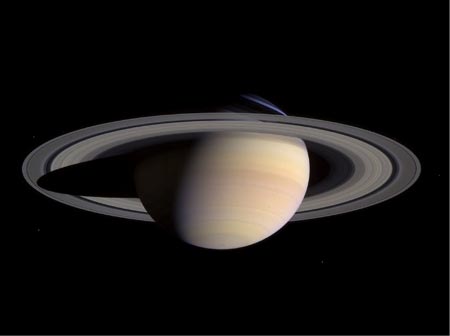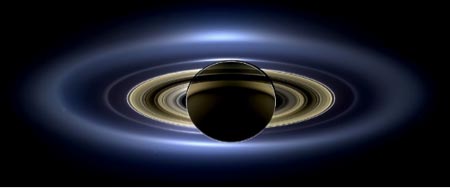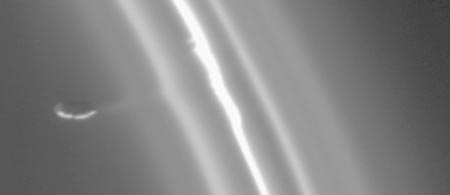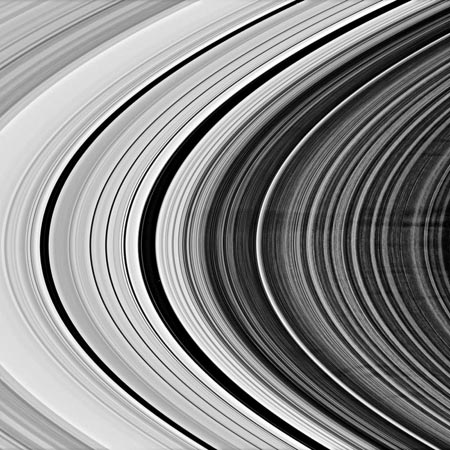8.11: Saturn’s Rings
- Page ID
- 244277
\( \newcommand{\vecs}[1]{\overset { \scriptstyle \rightharpoonup} {\mathbf{#1}} } \) \( \newcommand{\vecd}[1]{\overset{-\!-\!\rightharpoonup}{\vphantom{a}\smash {#1}}} \)\(\newcommand{\id}{\mathrm{id}}\) \( \newcommand{\Span}{\mathrm{span}}\) \( \newcommand{\kernel}{\mathrm{null}\,}\) \( \newcommand{\range}{\mathrm{range}\,}\) \( \newcommand{\RealPart}{\mathrm{Re}}\) \( \newcommand{\ImaginaryPart}{\mathrm{Im}}\) \( \newcommand{\Argument}{\mathrm{Arg}}\) \( \newcommand{\norm}[1]{\| #1 \|}\) \( \newcommand{\inner}[2]{\langle #1, #2 \rangle}\) \( \newcommand{\Span}{\mathrm{span}}\) \(\newcommand{\id}{\mathrm{id}}\) \( \newcommand{\Span}{\mathrm{span}}\) \( \newcommand{\kernel}{\mathrm{null}\,}\) \( \newcommand{\range}{\mathrm{range}\,}\) \( \newcommand{\RealPart}{\mathrm{Re}}\) \( \newcommand{\ImaginaryPart}{\mathrm{Im}}\) \( \newcommand{\Argument}{\mathrm{Arg}}\) \( \newcommand{\norm}[1]{\| #1 \|}\) \( \newcommand{\inner}[2]{\langle #1, #2 \rangle}\) \( \newcommand{\Span}{\mathrm{span}}\)\(\newcommand{\AA}{\unicode[.8,0]{x212B}}\)
Saturn’s rings are made up of particles that range from dust-size to meters in diameter. The rings are mostly water and ice in composition, with some rocky silicate materials. Galileo Galilei first observed them in 1610; he could not discern them as rings and referred to them as the ears of Saturn . In 1655, astronomer Christian Huygens hypothesized that Saturn had a ring, based on his telescopic observations. Giovanni Cassini suggested in 1655 that Saturn’s ring was actually made up of numerous smaller rings with gaps or divisions between these smaller rings.Saturn exhibits seven major rings with multiple divisions and gaps in the rings. The outer F ring is twisted and knotted like a piece of taffy; this is due to interactions of the F ring with Saturn’s moon Prometheus. There are small moons, called shepherd or sheepherder moons , which orbit near the outer edges of a ring or within gaps in the rings.




These sheepherder moons maintain a sharply defined edge to the ring. Radial features in the B ring, called spokes, were suggested by Steve O’Meara (Earth observations) and confirmed by spacecraft. These spokes , seasonal in nature, appear to be caused by electrostatic forces. A quite-distant ring of dust was discovered in 2009, called the Phoebe ring, and the Saturnian moon Phoebe that is not visible in Earth-based telescopes.

Saturn’s rings via NASA Hubble Space TelescopePublic Domain | Image courtesy of NASA.

Saturn’s rings, with Saturn blocking the Sun via NASA Cassini SpacecraftPublic Domain | Image courtesy of NASA.

Saturn’s F ring, with the moon Prometheus pulling material from the ring via NASA Cassini SpacecraftPublic Domain | Image courtesy of NASA.

Spokes in Saturn’s B ring via NASA Cassini SpacecraftPublic Domain | Image courtesy of NASA.
CC licensed content, Original
- Provided by: Florida State College at Jacksonville. License: CC BY: Attribution

